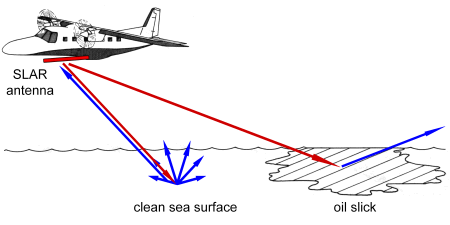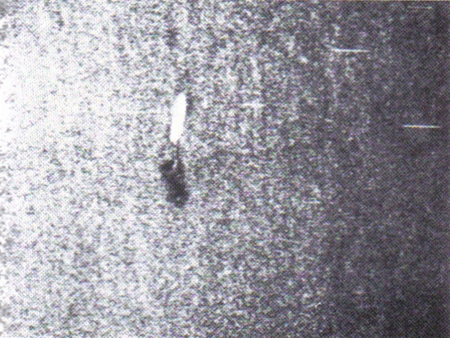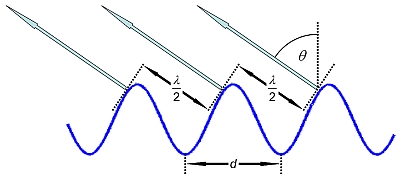Supplement 2.16: The Side-looking Airborne Radar (3/3)
Oil detection
We have seen that a SLAR is an imaging radar, and its data give a map of the backscatter of the overflown area. The backscatter from the sea surface is dependent on wind and waves. When no wind and waves are present, the sea surface is amost perfectly flat. Then the radar pulses are reflected just like a light beam on a mirror surface: except for pulses emitted vertically downwards (which are not used anyway) the radar pulses are reflect away from the aircraft, and no signal intensity would be measured. When wind is present waves will appear: capillary waves having wavelengths of a few millimetres at wind speeds of slightly more than 50 cm/s, and also gravity waves with larger wavelengths at higher wind speed. It is this surface roughness which gives rise to backscatter signals that are detected by the SLAR antenna even at large incidence angles θ of the radar pulse. The reason is that there are always wave facets with an orientation, such that the normal to the facets points into the direction of aircraft, thus causing reflection towards the SLAR antenna.

Detection of oil on the sea surface is based on the different backscatter efficiency of an oil slick
from that of the surrounding unpolluted area. Oil on the water surface dampens capillary waves very
efficiently, ripple waves on the sea surface disappear, thereby lowering the radar backscatter towards the SLAR antenna. The damping effect occurs
with very thin surface films of a few micrometre thickness, and has been observed even with layers
of one molecule thickness (monomolecular films). Therefore, SLAR is very efficient for detecting oil
films, but there is no information on the film thickness in the SLAR images.

Source: The Archimedes 2 Experiment, Joint Research Centre, Ispra Establishment
Related SEOS links
- Worksheet: Long-range Oil Spill Detection with Radar,
as html page or as printable rtf file - Visual Appearance of Oil on the Water Surface
- The UV-IR Scanner
- The Microwave Radiometer (MWR)
- The Laser Fluorosensor (LFS)

